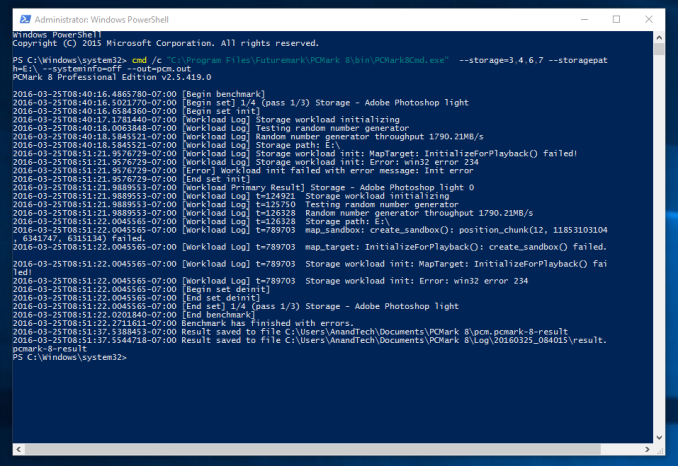SanDisk Extreme 900 USB 3.1 Gen 2 Portable SSD Review
by Ganesh T S on April 11, 2016 8:00 AM ESTTestbed Setup and Evaluation Methodology
Evaluation of DAS units on Windows is done with the testbed outlined in the table below. For devices with a USB 3.1 Gen 2 (via a Type-C interface) connections (such as the SanDisk Extreme 900 1.92TB that we are considering today), we utilize the USB 3.1 Type-C port enabled by the Intel Alpine Ridge controller. It connects to the Z170 PCH via a PCIe 3.0 x4 link..
| AnandTech DAS Testbed Configuration | |
| Motherboard | GIGABYTE Z170X-UD5 TH ATX |
| CPU | Intel Core i5-6600K |
| Memory | G.Skill Ripjaws 4 F4-2133C15-8GRR 32 GB ( 4x 8GB) DDR4-2133 @ 15-15-15-35 |
| OS Drive | Samsung SM951 MZVPV256 NVMe 256 GB |
| SATA Devices | Corsair Neutron XT SSD 480 GB Intel SSD 730 Series 480 GB |
| Add-on Card | None |
| Chassis | Cooler Master HAF XB EVO |
| PSU | Cooler Master V750 750 W |
| OS | Windows 10 Pro x64 |
| Thanks to Cooler Master, GIGABYTE, G.Skill and Intel for the build components | |
The full details of the reasoning behind choosing the above build components can be found here.
Evaluation involves running synthetic benchmarks such as ATTO and CrystalDiskMark. We also process custom test-suites (transfer of a set of photographs and video files) from a RAM disk on the testbed. Finally, we also run PCMark 8's storage bench on the external device.
The power consumed by the bus-powered device is measured using the Plugable USBC-TKEY interposer. The USBC-TKEY was plugged into one of the Thunderbolt 3 / USB 3.1 Gen 2 Type-C ports enabled by the Alpine Ridge controller. While the USBC-TKEY acts as a transparent interposer for the host's port, it is connected to a Ubuntu system for data gathering purposes via its micro-USB port. The power consumption is tracked while CrystalDiskMark processes its traces.
The Extreme 900 turned out to be a very interesting DAS unit to review. In our initial trials on the Skylake testbed (specified above), the performance numbers turned out to be very inconsistent. While performance was definitely better than any USB 3.0 flash drive for most tests, there were a few with very disappointing numbers. Assuming that it was a compatibility issue for the ASM1352R with the Alpine Ridge controller, we tested out on our Haswell testbed with an ASRock PCIe card (sporting an ASMedia controller). The results were similar. To complicate matters further, it turned out that none of our testbeds could process the PCMark 8 storage bench on the drive. All attempts failed with a workload initialization error.
While trying out various trials, we decided to completely get rid of any partition information on the drive. Using 'diskpart', 'select disk X' and 'clean' commands, we reinitialized the drive and formatted it afresh in exFAT (the drives had originally come pre-formatted in exFAT along with SanDisk's software encryption app). After this process, the PCMark 8 storage bench started working without issues. Benchmark numbers from ATTO and CrystalDiskMark also became consistent from run to run.











31 Comments
View All Comments
MattMe - Tuesday, April 12, 2016 - link
The comment about being normal was written tongue firmly in cheek.pav1 - Tuesday, April 12, 2016 - link
Normal people don't post on forums.Ratman6161 - Monday, April 11, 2016 - link
Both SanDisk and Samsung have smaller capacity, lower priced versions of their drives that would be of interest. For example on Amazon SanDisk has a 960GB version for $500 which sounds like just 1 960 GB instead of two in RAID 0 (which may also solve the issue of no trim if its a single drive rather than RAID 0???). Samsung has: 250 GB T3 for $129, 500 for $197 and 1 TB for $427. The 500 GB actually seems pretty reasonable to me as its big enough to fit several VM's of the size I'd use it for and the price is still relatively low.ganeshts - Monday, April 11, 2016 - link
The 960GB version of the Extreme 900 is 2x 480GB in RAID-0jameskatt - Saturday, May 7, 2016 - link
The Mushkin Enhanced Reactor TC 2.5" 2 TB SATA III MLC Internal Solid State Drive (SSD) MKNSSDRE2TB-TC from Amazon costs $500. Place this in a thin $20 USB 3.0 enclosure. You'll save $300 over the SanDisk and Samsung external 2TB SSDs.zepi - Monday, April 11, 2016 - link
Sounds like a decent way of increasing the iops/storage when running a bunch of virtual machines on a laptop or even a desktop machine and taking them with you whereever you go.Not free for sure, but compared to the price of internal storage options and impossibility of even having 2TB in most laptops, this is not bad.
BrokenCrayons - Monday, April 11, 2016 - link
External storage for a virtual machines seems like a good use case for the Extreme 900. I can't think of too many others that would justify the fairly steep MSRP vs storage capacity that can readily benefit from the added performance.ImSpartacus - Monday, April 11, 2016 - link
It's sad that we have to say, "usb 3.1 gen2" now...Flunk - Monday, April 11, 2016 - link
USB 3.1 Gen 1 is such a scam.Gunbuster - Monday, April 11, 2016 - link
I would have thought $800 would afford you a enclosure design slightly more exciting than what can be had on amazon or eBay for $10